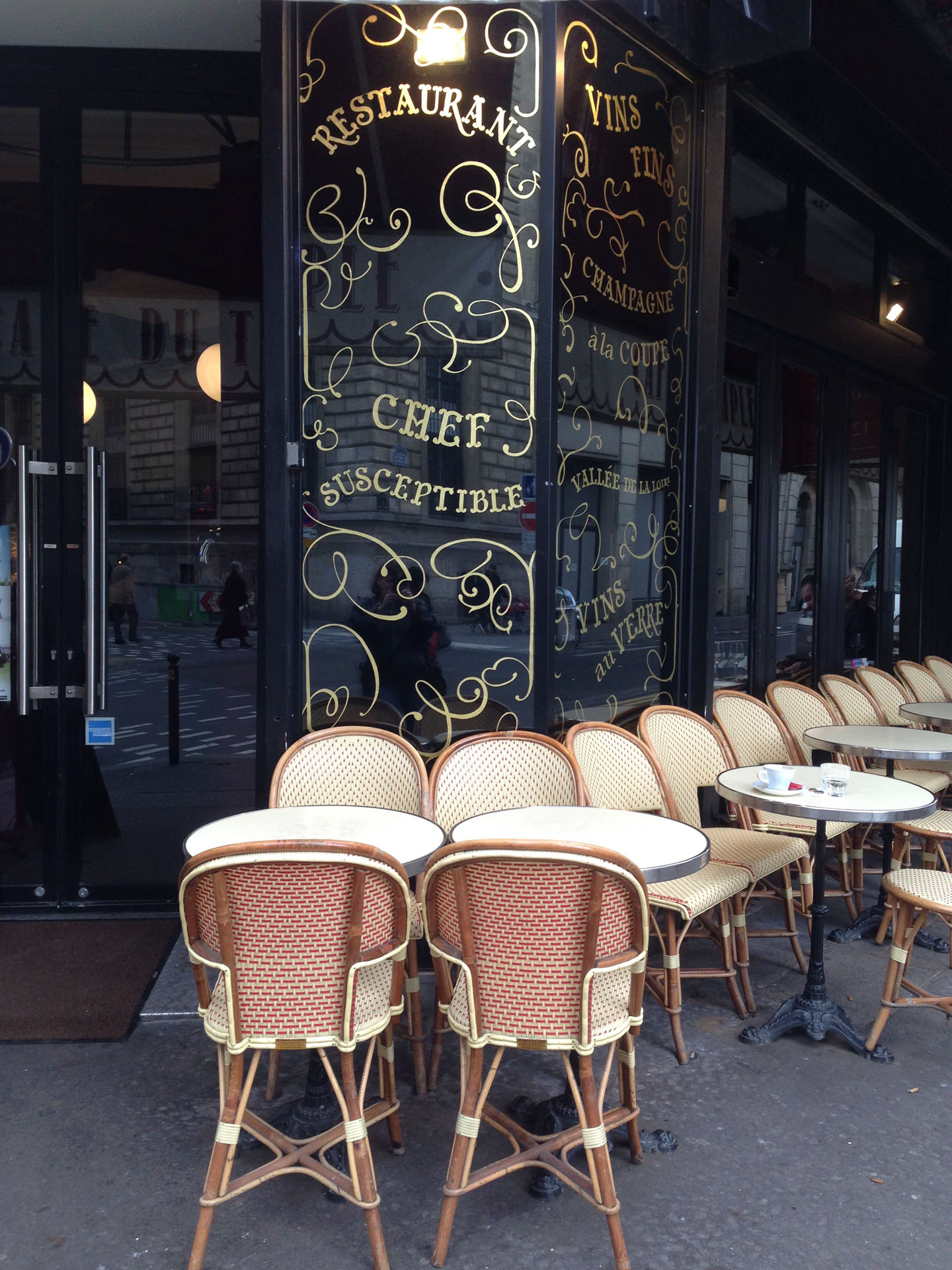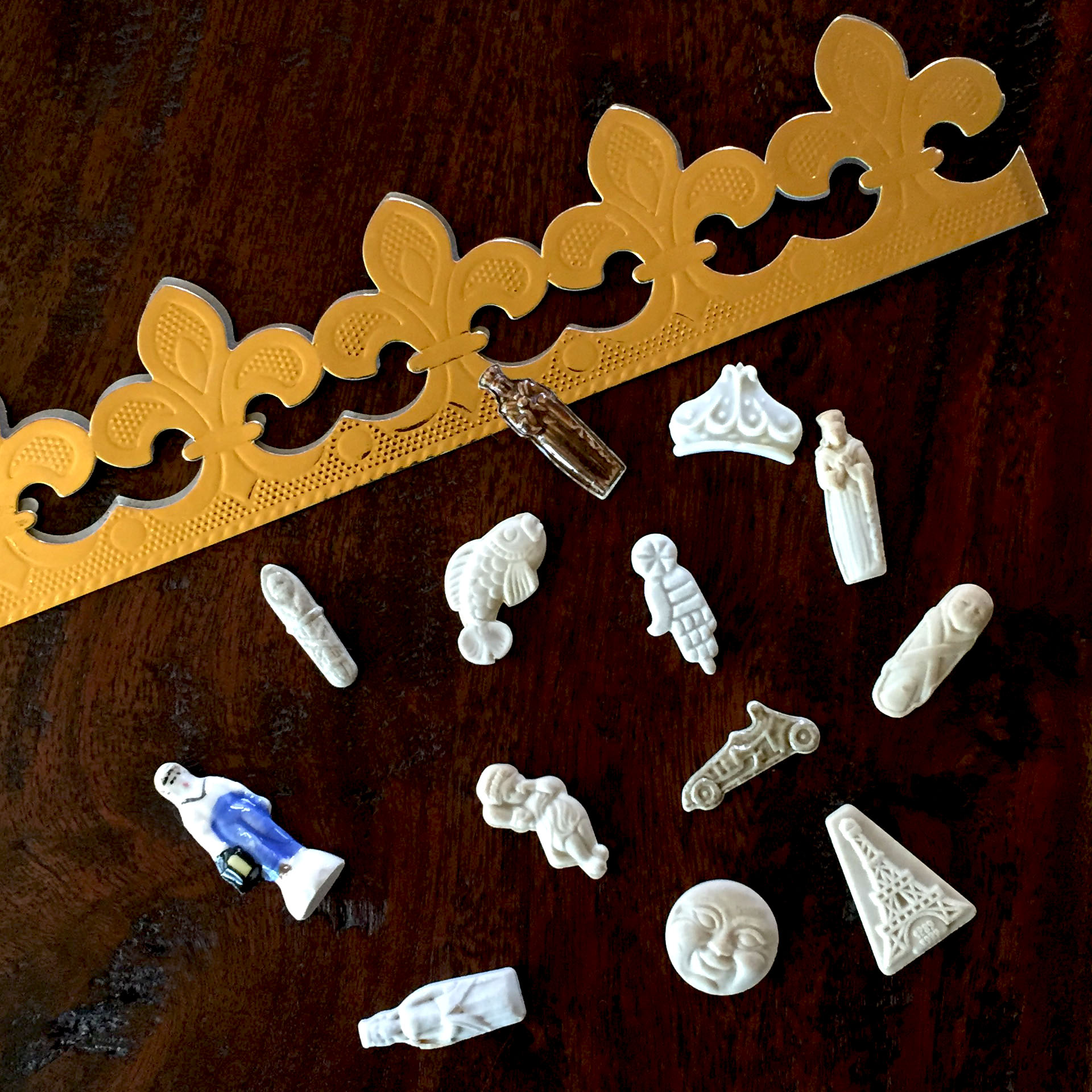And all this time, your biggest concern was a “rude” waiter! Kidding, just kidding: you must watch out for the chef, too. Bistro on rue du Faubourg du Temple, 11th arrondissement.
Vocabulary
Susceptible: oversensitive

And all this time, your biggest concern was a “rude” waiter! Kidding, just kidding: you must watch out for the chef, too. Bistro on rue du Faubourg du Temple, 11th arrondissement.
Vocabulary
Susceptible: oversensitive

Sometimes the photographer becomes the subject. Palais Royal in the first arrondissement ranks as one of the most popular locations for photo shoots: the juxtaposition of classic architecture and modern elements (the often decried Buren columns) provides interesting props.

When you’re a frequent Paris visitor, it’s easy to get sucked into your comfort zone: you stay at the same hotel or apartment; you have your favorite neighborhood and know exactly which pastry shop has the most succulent tarte au citron; you’re on a first-name basis with the chef who runs that great bistro you love so much.
I understand the attraction: you don’t want to be a mere tourist; you want to belong. I’ve been guilty of doing that myself. So, let me tell you about this little game I’ve been playing for a few years. I picked up two of the free maps that you routinely find at the airport or in hotel lobbies (they usually advertise the Galeries Lafayette department store.) I unfolded one of them, cut the city map along the grid, and obtained about 120 squares. I did allow myself to discard those on the outer edge where the only place of interest was the boulevard périphérique… Each one measures about 1.25” x 1.25” and I keep them all in a box. Before each visit, I pick one. Randomly. Then I make sure to devote at least half a day to explore my “assigned” area, trying to walk every little street, paying attention to architectural details, looking for surprising places, and taking photos of what I encounter.
I keep the second map as a reference so I can easily spot where my square fits overall: some of the mostly residential areas can be hard to locate when they don’t include part of the river or a recognizable monument. Once I know where I’ll be walking, I make a copy of a real street map of the area and take it along: I can always see the “boundaries” of my square and don’t need to rely on a phone app. I strongly recommend Paris 3 Plans par Arrondissement (which is a bit hard to find these days) but I’ve also used the Michelin Paris Plan (royal blue #11.)
You can also decide to explore beyond the strict limits of your square: it usually makes sense to cover the length of a street or walk around a whole park. Whether you consult guides, prepare your itinerary, or just go blindly is entirely up to you. Either way, I’m sure you’ll make unexpected discoveries. Give it a try!
Vocabulary
Tarte au citron: lemon tart
Boulevard péripherique: the beltway circling around the city

Macarons come in one shape, two sizes (usually), and a multitude of colors. I bet the merchandisers at Ladurée love to work with those delicious little circles to create stunning window displays. Rue Bonaparte, 6th arrondissement.

A long time ago, the traditional galette des Rois was spiked with a dry bean, hence the name fève. When I was a young girl, the bean had already been replaced by a white porcelain baby Jesus. In the late Sixties, plastic supplanted porcelain and religious icons made way to secular symbols: the sun, a four-leaf clover, etc.
As galette season started to stretch to a whole month instead of a single week, bakers foresaw a new marketing opportunity: if fèves were perceived as collectibles, more cakes would be sold. It started will colorful ceramic santons (the Provençal figurines that populate nativity scenes) and expanded to depictions of cartoon characters, baby animals, classic cars, or even a real gold coin!
Fève collectors are known as fabophiles and often scout vide-greniers to enrich their collection. They can even compare their treasures to the 20,000+ samples exhibited at the Musée de la fève in Blain (Loire-Atlantique.)
Vocabulary
Galette des Rois: traditional cake served for the Epiphany
Vide-grenier: the French equivalent of a garage sale (literally, to empty one’s attic)

Each French holiday has its own rhythm, its own traditions and, most importantly, its own dessert. After the Bûche de Noël* for Christmas and the Omelette Norvégienne for New Year’s Eve, we usher in January with the Galette des Rois. Sometimes compared to the Kings cake served in New Orleans for Mardi Gras, the galette is a decidedly different dessert. Imagine a buttery layer of frangipane (creamed almond powder) sandwiched between two flaky disks of puff pastry: at its best, it’s light, not too sweet, and the perfect accompaniment to a chilled glass of Champagne demi-sec.
That’s what the adults in the (dining) room enjoy. Children get more delight out of finding la fève in their slice of galette: before it is baked, a trinket is hidden between the layers of puff pastry; the person who is lucky enough to bite into the fève gets to be crowned king or queen for the day. Traditionally, the youngest child scoots under the dining room table while the galette is cut and calls the name of a recipient before each slice is served. In our house, it was my sister Françoise’s responsibility –and privilege. I grew a bit weary of the whole process when I realized that Mom would INVARIABLY strike the fève when cutting the galette, thereby killing the surprise for everybody around the table. I eventually got my own “epiphany”: I joined my sister under the table so I could be as blissfully ignorant as she was.
Unless you live close to a good French pastry shop, purchasing a galette in the USA is no small feat. However, making one yourself is not necessarily a difficult endeavor, especially if you use store-bought puff pastry. Here is my recipe.
Galette des Rois
Ingredients
2 sheets of puff pastry
½ cup sugar
4 Tbsp of butter, softened
1 ¼ cup almond meal
3 eggs, separated
1 drop almond extract
2 Tbsp of rum
A porcelain fève (or dried bean, or whole almond)
Directions
Preheat the oven to 360º F. Cut two 9" disks into the puff pastry sheets (use a sharp knife and an upturned plate to guide you). Line a cookie sheet with parchment paper and set one disk on top of it. Cream the sugar, almond meal, and butter together. Incorporate 2 eggs, almond extract, and rum. Mix the yolk from the remaining egg with 1 Tbsp of water; with a pastry brush, apply the egg wash at the edges to trace a one-inch ring. Pour the almond cream in the center of the puff pastry disk and spread up to the egg wash ring. Bury the fève into the almond cream. Top with the second disk of puff pastry and press the edges together with your fingers to seal. With the dull side of a small knife, push the edges of the dough inward in eight equidistant places; draw a crisscross or decorative pattern on the top of the galette; brush with the egg wash, making sure not to drip over the sides. Bake in the center of the oven for 30 minutes. Serve at room temperature or slightly warm.
Vocabulaire
La Bûche de Noël: log shaped cake
L’Omelette Norvégienne: baked Alaska
La Galette des Rois: puff pastry cake served for the Epiphany
Demi-sec: extra dry
La fève: a trinket hidden in the galette. Originally, a dried bean.
Read more about les fèves.